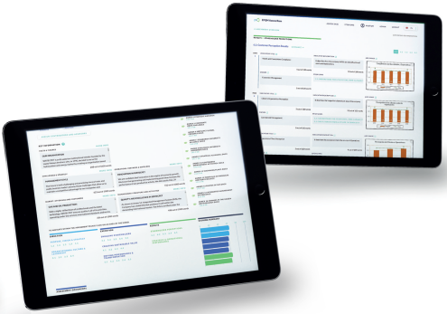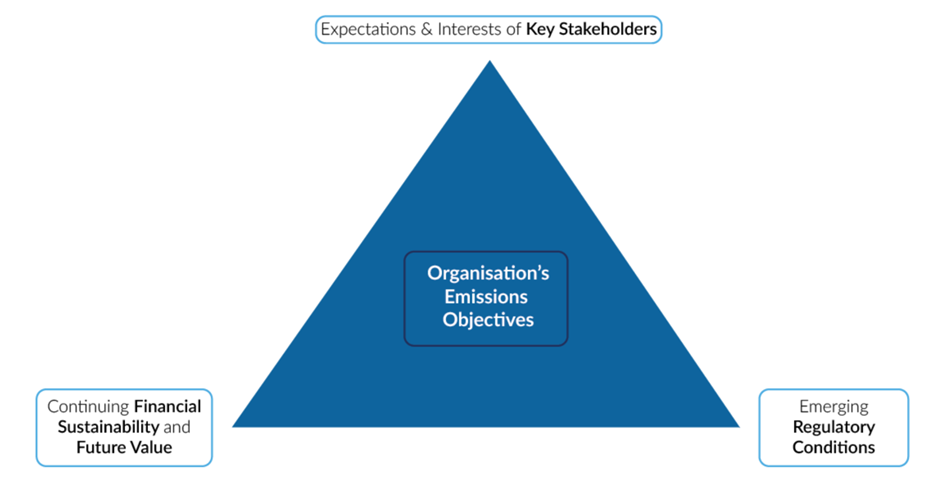Net Zero
As a responsible organisation, you understand the need to play your part in tackling global challenges that we are all facing. Having a clear Economic, Environmental, Social and Governance (EESG) strategy built on a commitment to *Sustainable Development will help your organisation to play its part in addressing these challenges.

Get a deeper understanding of the diagnostic tools to help your organisation make progress in the achievement of its Net Zero ambitions and achieve success in Creating Sustainable Value for your Key Stakeholders based on Net Zero principles.
Moving to a Net Zero economy presents a huge challenge but also an opportunity for future global economic resilience based on a transition to alternative business models and ways of working.

The Net Zero Diagnostic Tools have been developed working in partnership with FutureZero, taking advantage of the leading-edge knowledge, expertise and network collaborations they have acquired in this vital subject in recent years. http://futurezero.com
Try the Net Zero Questionnaire
Book your demo
The EFQM Net Zero Diagnostic Tools
STRUCTURE
The structure of the Net Zero Lens replicates the structure of the EFQM Model, i.e., the assessment begins with an exploration of the Direction of your organisation, referenced against its current and desired relationship with the concept and practices of Net Zero thinking.
Following on from this, you are invited to consider how well your organisation is Executing the commitments it made in Direction vis-à-vis its Net Zero ambitions.
Finally, your organisation is encouraged to consider if the Results it is achieving are in line with the fulfilment of its Net Zero ambitions and whether it is using these results to anticipate and plan for the future.
Using this Lens gives your organisation the opportunity to perform a gap analysis between its current competence and desired state for Creating Sustainable Value, based on Net Zero principles, in relevant timescales.
It is an easy-to-use questionnaire that consists of 28 statements, compiled under the three headings of Direction (8 statements), Execution (12 statements), & Results (8 statements).
You are invited to respond to each of these statements, offering evidence of your efforts to achieve Net Zero structured under the three pillars of Direction, Execution & Results.
Responding to this rapid organisation diagnostic tool statements in this way will help your organisation:
- Compare and contrast individual perceptions within the team
- Gain a first stake in the ground of its current strengths and opportunities for improvement in making the principles of Net Zero come alive within the organisation
- Start to create a strategic approach and roadmap for the integration and embedding of Net Zero principles into its operations
This diagnostic tool includes the possibility to produce an overall score for Direction, Execution & Results as well as the opportunity to record the reasons for specific scoring decisions in each of the three Pillars.
HOW TO COMPLETE IT AND THE TIME NEEDED
There is no single best way for you to complete this questionnaire, it will depend on several factors: –
- Are you completing it as one individual or will you be completing it as a team? Experience of using the questionnaire has shown that more value will be gained if it is completed at the same time by a team of work colleagues rather than by any one individual.
- To what degree do you want to complete the questionnaire without any preparation in advance?
- Will you depend on your innate knowledge & understanding of your organisation’s current activities in the Net Zero arena or will you choose to gather some data/evidence before starting to answer the questions?
- Depending on your answers to these questions you could consider allocating between 1 & 4 hours to complete the questionnaire
USING THE OUTCOMES FROM THE ASSESSMENT
A starting point on next steps is to consider the assessment outcomes with reference to the following questions:
- Where is the low hanging fruit/the quick wins?
- What are the 20% of opportunities that will deliver 80% of the desired outcomes? (Pareto analysis)
- What outcomes from the assessment have indicated the most significant negative impacts on the organisation’s Net Zero ambitions within its operations, products, services, solutions, and value chain?
- Where do you think your organisation, given the nature of its business, operations, and value chain, has the biggest potential to make a positive impact with its Net Zero ambitions?
- What contribution can your organisation make to help the world get closer to Net Zero performance, not just meeting but exceeding in its responsibility to address potential and actual negative impacts on people and the environment that are linked to its operations, products, services, solutions and value chains?
- By applying its knowledge, skills, and other capabilities, what are the products, services, solutions, and investments that your organisation can offer to help the world achieve the Net Zero target, benefitting people and the environment, today and for the future?
It is also important that your organisation makes sure it is aware of any specific legislation that is either already in place, or planned to appear on the horizon soon, that has the potential to make an impact on its ability to achieve Net Zero in its operations, either at the Sector, Country, or Regional level. Refer to the “Useful websites” section at the end of this document.
Finally, it is worth remembering that although the EFQM Model has proven itself to be an effective change management framework, it is the People that determine whether a successful change will happen and not the framework.
Once you have determined your next steps in the drive to Net Zero, how will you:
- Engage motivate, recognise, and reward your People for their efforts?
- How will you help them to see where and how they fit into the Net Zero world and what their impact could be, should be, currently is?
- How will you encourage them to look outwards to identify the opportunities, including the importance of identifying and sharing problems across the Value Chain that need resolution?
The Net Zero Ambition
THE NEED & CONTECT FOR A NET ZERO TRANSFORMATION
At the heart of a Net Zero world is the desire to achieve, globally, Net Zero carbon emissions by 2050.
The necessary direction of travel to get there is not the question, it is clearer than ever, the “burning” question is the speed of transition, i.e., many organisations are not transitioning to Net Zero fast enough and, globally, we will only achieve our ambition if every link in the chain is up to speed.
Governments, sectors, industries and the individual organisations that make up those sectors and industries, plus their financial service providers, need to have Net Zero transition plans in place to transform their business to be Net Zero by 2050 or earlier. Organisations will increasingly be asked by Key Stakeholders to disclose a plan for how their business model is compatible with a Net Zero economy, how this plan is incorporated into their long-term strategy and how governance is reviewed.
Net Zero will require the largest capital reallocation in human history. (McKinsey, 2021)
SO, IN THIS NECESSARY TRANSFORMATION TO NET ZERO, DO YOU WANT TO BE A WINNER, A SURVIVOR OR A CASUALTY?
If you are thinking about developing a Net Zero strategy for your organisation, you need to be able to answer the following questions:
- From where does the race to Net Zero in 2050 originate?
- How are world leaders working together to reach Net Zero in 2050?
- What are the effects of this race on individual organisations?
- How will changing Customer and Employee Values impact my business model?
- What does an ideal Net Zero transition timeline look like?
- Transition or Transformation: The Pathways
- What are the steps to creating a Net Zero business model?
1. FROM WHERE DOES THE RACE TO NET ZERO IN 2050 ORIGINATE?
The 2015 Paris Agreement and the 2021 Conference of the Parties (COP 26). The 2015 Paris Climate Agreement saw governments and sector leaders from around the world come together to discuss the current state of the climate and create a plan for how to address the damage we have caused and continue to cause to our planet. This legally binding agreement requires all the participating countries to reach Net Zero greenhouse gas (GHG) emissions by the year 2050 or earlier, with the goal of limiting global warming to 1.5 degrees Celsius compared to pre-industrial levels.
Countries will carry out this goal using Nationally Determined Contributions (NDCs), which are the various steps they will take to reduce carbon emissions. NDCs were originally supposed to be reviewed and revised every five years, to be more aggressive each time. However, at COP 26 it was agreed they would be revisited each year creating more accountability and even more aggressive targets.
2. HOW ARE WORLD LEADERS WORKING TOGETHER TO REACH NET ZERO IN 2050?
At COP 26, 140 countries committed or recommitted to reach Net Zero by 2050. Participating countries adopted Article Six which supplies international guidelines for creating carbon markets. At the time of writing this article, the details of these guidelines are still being ironed out, but we can be sure the global push for regulated carbon markets will affect many industries in the coming years. Other resolutions reached at COP 26 included over 40 countries signing the global coal to clean power transition agreement. The goals of this agreement are to replace all gas power plants with carbon free energy such as wind, solar, hydroelectric or nuclear power generation by 2035. By 2040, all the remaining coal plants would be closed or be upgraded to use filtration systems to catch the emissions. Additionally, over 100 countries have committed to reducing the amount of methane emissions by 30% by the year 2030 compared to 2020 levels.
3. WHAT ARE THE EFFECTS OF THIS RACE ON INDIVIDUAL ORGANISATIONS?
3.1 Carbon Costs
These agreements, and the structures and policies that accompany them, will create carbon costs for individual organisation. Carbon costs place a fee on each tonne of carbon greenhouse gas a country produces. This means that organisations that release more carbon will pay more taxes. The International Energy Agency in its modelling of Net Zero scenarios has used a carbon price of between US$160 and US$205 per tonne by 2040. However, this may be subject to change due to geopolitical events.
3.2 Emissions Trading Systems (ETS)
ETS puts a cap on the amount of greenhouse gas a country can release into the atmosphere. This enables a carbon market where companies can buy carbon credits. Since there is a finite number of credits, the amount of greenhouse gases that countries, sectors and industries emit can be limited and reduced. The greater the excess of demand for these credits, the higher the price. Both Carbon Costs & ETS approaches limit the amount of carbon put into the atmosphere and require organisations to rethink where their GHG emissions come from, and how they can reduce them in the interest of saving money and staying competitive.
3.3 Cross border carbon adjustment mechanism
More recently at COP 26, a cross border carbon adjustment mechanism started to take shape. This mechanism will act as a process to level-out the carbon costs across borders and, eventually, there will be no place to hide from the true cost of carbon and GHG emissions. These costs will impact both an organisation’s bottom line and balance sheet.
3.4 Finance
It is not just countries aligning to reach Net Zero by 2050. Financial services providers are changing their strategies with their customers as well. The Glasgow Financial Alliance for Net Zero (GFANZ) is a group of institutional investors, commercial banks and insurance companies that is beginning to ask companies for their Net Zero transition plans. If a company does not have a defensible Net Zero Transition Plan, investors and banks who are GFANZ members may decline to invest or lend in that company. Or even pull their existing funding. The Net Zero Asset Owners Alliance, part of GFANZ, is working to create metrics and timelines to guide the transition to Net Zero. This will supply an accountability system for companies to measure up to and adjust their current strategies. The International Sustainability Standards Board (ISSB) was launched by the International Foundation for Reporting Standards (IFRS) at COP26. IFRS has committed creating globally recognised Economic, Environmental, Social and Governance (EESG) reporting standards including the reporting of GHG emissions. The creation of these standards is backed by the International Organization of Securities Commissions (IOSCO) who coordinate the stock exchanges around the world.
4. HOW WILL CHANGING CUSTOMERS AND EMPLOYEE VALUES IMPACT MY BUSINESS MODEL?
The push for Net Zero is also coming from Customers and Employees. Studies have shown that Millennial and Gen Z Customers prefer to buy products that align with their values. This means they are looking for sustainable products and will go as far as boycotting products that cause harm to the environment to produce. The same Customers are also inclined to make Values-based decisions about where they will work. As employees they are more likely to turn down jobs if the Values of the organisation are not environmentally sound.
5. WHAT DOES AN IDEAL NET ZERO TRANSITION TIMELINE LOOK LIKE?
- By 2025 your company should have reengineered your core process and product portfolio to result in a 15 to 30% reduction in absolute GHG
- By 2030 your business model redesign and transformation should have resulted in 45 to 60% reductions
- After 2030 you should continue to have 5-8% or greater year over year reduction in GHG emissions until you achieve a Net Zero business model goal no later than 2050 and ideally much earlier by setting aggressive targets for business model redesign
- Are you thinking about how your entire industry ecosystem can get to Net Zero emissions by 2050?
6. TRANSITION OR TRANSFORMATION: THE PATHWAYS
There are many organisations around the world that have already made great headway in changing how they work and setting Net Zero goals. This can be done by redesigning the current business model into a Net Zero business model.
For some this is just a transition, while for many others it will be a complete transformation of all components of the business model to achieve their desired objective, whether that’s Net Negative, Absolute Zero or Net Zero GHG emissions.
There are four identified pathways (they’re not mutually exclusive):
- Some changes are made at Net Zero processes level with the goal of eco efficiency. For example, Amazon is replacing its fleet of vehicles to a 100% clean fleet or take Google’s example of transitioning to a 24/7 carbon free energy source to power all its data centres around the world.
- Other companies have started making changes at the Net Zero products and services level. Harley Davidson now sells e-motorcycles and BMW produces electric vehicles.
- Changes are also happening at the business model level. In addition to transforming its product portfolio to centre around smart, sustainable zero emission buildings, Johnson Controls has set Net Zero goals that will redesign the complete business model by investing 75% of R&D in new and sustainable zero emissions products.
- For some, the change has already begun to take place at an industry ecosystem level. The IKEA Group is undergoing business model ecosystem transformation with the goal of transforming into a circular, climate positive, business ecosystem by 2030.
For organisations, regardless of whether it is a transition or transformation pathway, the timeframe to reach desired Net Zero outcomes is long-term but plans and progress, against credible interim targets, need to be evident in the relative short-term to meet stakeholder expectations.
7. WHAT ARE THE STEPS TO CREATING A NET ZERO BUSINESS MODEL?
You need to first understand where your carbon emissions come from – by completing a GHG audit on your current business model – before you can start deciding how to eliminate or reduce them.
Step 1: Calculate all Scope 1, 2 & 3 GHG emissions in your current business model
Approaching the GHG emissions audit through continuous improvement cycles is a good way to start. Using primary transaction information provides the most valid, reliable and defensible GHG measurement approach
What are the different scopes of carbon emissions?
- Scope 1: Scope 1 GHG emissions are those generated directly by your core business processes. Thus, having end to end business process maps can guide this part of the GHG emissions analysis and audit
- Scope 2: Scope 2 GHG emissions are those generated from your use of purchased energy consumed to run your core business processes
- Scope 3: Scope 3 GHG emissions include 15 possible categories grouped into two major segments – upstream and downstream. For most organisations, upstream and downstream GHG emissions account for 70 to 90% of that total business model’s GHG emissions, making Scope 3 emissions one of the most critical areas to address
Recent research, using a survey of over 1500 companies, found a GHG measurement error rate of over 45% in companies. Measurements of GHG emissions is subject to the widely accepted GHG Protocol https://ghgprotocol.org
Step 2: Calculate the organisation’s total tonnes of CO2e
The next step is to calculate your current business model carbon intensity by dividing your total business model GHG emissions by each $1 million in revenue. This makes it easy to compare and contrast your business model with other organisations in your sector or industry and recognise the scale of the challenge of getting to zero emissions.
Step 3: Calculate your company’s Carbon Adjusted Return On Capital (CAROC)
Calculate your CAROC based on your current GHG Emission disclosures stress tested up to $100 per tonne of carbon fee impact on your current business model
Note: There may come a time when you decide to move beyond your own organisation’s business model CAROC results and instead consider your entire sectoral or industry ecosystem as a positive CAROC business model with zero GHG emissions, ultimately becoming recognised as a winner in the transformed Net Zero global economy.
Summary
Once you have these core Net Zero benchmarks for business carbon intensity, those of your sector or industry and your comparable ranking, you can develop a GHG stress test
This can be accomplished by establishing reporting processes and business intelligence tools to establish baseline data that include:
- Scope 1, 2 and 3 GHG emissions
- CO2e tonnes per $1 million revenue.
- Carbon Adjusted Economic Profit. (Financial Sustainability)
- Carbon Adjusted Return On Capital (Future Value)
You can then report the findings to your Board or senior management and start to develop your organisation’s response to the Net Zero challenge
The Net Zero Ambition: Balancing Priorities
Ultimately, every organisation must determine for itself the chosen pathway to Net Zero because there is no “one size fits all” model. Indeed, part of the Net Zero challenge for each organisation is for it to determine what that destination looks like and how it will get there.

There are several possible destination pictures, and we encourage each individual organisation to consider its own emissions objectives set within a model that triangulates its Net Zero ambition within the context of: –
- The expectations (and interests) of its Key Stakeholders
- Emerging regulatory conditions in the markets in which it operates
- Its continuing Financial Sustainability and Future Value adjusted for likely future carbon costs.
This triangulation model recognises there are choices and trade-offs to be made and that a pure Net Zero is not necessarily the ultimate goal for every organisation. Some may choose to go beyond Net Zero – Absolute Zero or Net Negative for example – while others should understand the implications of falling short.
But these decisions and their implementation are certain to pose challenges for the people competences and capabilities, as well as the organisational capacity for innovation that is required for the necessary transformation to succeed.
This EFQM diagnostic tool is designed to help you identify those challenges and walk you through the considerations in moving from where you are now to where you might decide you want to be in the future.
Useful websites
Feel free to click on the links below to access several useful websites and further reading on the subject.
- The EFQM Net Zero Lens – https://efqm.org/efqm-lens-series/net-zero/
- The EFQM UN SDG Lens – https://assessbase.digitalefqm.com/find-out-more/un-sdgs
- The United Nations Climate Action Plan – https://www.un.org/en/climatechange/net-zero-coalition
- The European Union’s Climate Action Plan
https://ec.europa.eu/clima/eu-action/climate-strategies-targets/2050-long-term-strategy_en - The United Nations Sustainable Development Goals – https://sdgs.un.org/goals
- The United Nations Framework Convention on Climate Change – https://unfccc.int
- The global coal to clean power transition agreement – https://ukcop26.org/global-coal-to-clean-power-transition-statement/
- The Sustainable Development Goal Climate Action (SDG 13) calls for urgent action on all fronts to combat climate change and its impacts
https://ec.europa.eu/eurostat/statistics-explained/index.php?title=SDG_13_-_Climate_action - 2021 Monitoring report on progress towards the SDGs in an EU context
https://eeac.eu/wp-content/uploads/2021/07/Eurostat-Pres.pdf - A European Green Deal – https://ec.europa.eu/info/strategy/priorities-2019-2024/european-green-deal_en
- Financial Stability Board (FSB) – https://www.fsb.org
- Intergovernmental Panel on Climate Change (IPCC) – https://www.ipcc.ch
- International Integrated Reporting Council (IIRC) – https://www.integratedreporting.org/resource/international-ir-framework/
- International Sustainability Standards Board (ISSB) – https://www.ifrs.org/groups/international-sustainability-standards-board/
- Task Force on Climate-related Financial Disclosures (TCFD) – https://www.fsb-tcfd.org
For further information on measuring GHG emissions:
- World Resources Institute/World Business Council for Sustainable Development Greenhouse Gas Protocol – https://ghgprotocol.org
- Relating Emissions targets and Net Zero objectives to climate change impacts through so-called Science Based Targets – https://sciencebasedtargets.org/
Acknowledgements
This Lens would not exist without the support of the many organisations and the individuals working within them that were a vital component in the testing of the draft Net Zero Lens Questionnaire and providing the invaluable feedback that has led us to this final version of the questionnaire.
EFQM offers its sincere thanks to this international group.
EFQM wishes to also acknowledge the support it has received from, and offer sincere thanks to, FutureZero, for its full engagement in the development of this Lens. Especially, we offer our sincere thanks to Mark van Clieaf and John Swannick for their willingness to share their knowledge and expertise, starting with the preparation and delivery of a very successful webinar in December 2021 on the subject to kick start the development process.
Contact us for a demo
Let us show you the power of Organisational Insights from AssessBase. Contact us for a demo today.
GLOBAL HEAD OF DIGITAL SERVICES
Vinciane Beauduin

